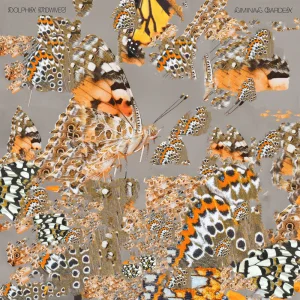Dolphin Midwives – Liminal Garden

Available Formats: LP & Digital
Time: About 40 minutes
Labels: Sounds et al: ETAL011 & Beacon Sound: BNSD031
Tracks: 1) Grass Grow, 2) Junglespell, 3) Castleshell, 4) Flux, 5) Temple IV, 6) Mirror, 7) Labyrinth I, 8) Temple V, 9) Satya Yuga, 10) Iridesce
From an early age I have been fascinated by the sound and look of a harp. While some watched the Marx Brothers for the comedy, I was waiting for the ritual of Harpo’s performance—the calm respite from the chaos. Later, it was Bach Partitas played by Nicanor Zabaleta and other harpists and ensembles, and then improvisations and atmospheres played by Andreas Vollenweider (who was unfortunately pigeon-holed in the ghastly ‘New Age’ record bins in the 1980s). Thank goodness there’s a new generation continuing to make music with their harps.
No matter the genre, hearing music from a harp can be a riveting and even a mystical experience. A harp can supplement the atmosphere of a larger work of music or it can stimulate on its own, generating inner subconscious reactions (as instrumental music tends to do). It can be abstract or symbolic—cascading water, sun in the clouds, soft gentle repetitions to calm or to be invited into another realm beside the present.
Sage Fisher composes and performs with a harp, percussion, effects, and her voice. She is an experimental sound artist from Portland, Oregon, and Dolphin Midwives is the name of her performance project. As far as I can gather Liminal Garden is her second full length album (Orchid Milk appears to be her first in 2016—available on her Bandcamp page). I think that Liminal Garden has mystical or spiritual references that I am not qualified to interpret (some mysteries are better left unsolved), but I speculate that this album is a journey of exploration in two episodes, whether it is experienced as a two-sided LP or as a continuous thread in a digital music stream.
Each of the two parts starts with an abstract centering and cleansing vocal prologue (Grass Grow and Mirror), where short themes are established and then altered with looping effects, samples and down and up octaves—a loosely narrated trip that gradually arrives at an altered state, where a sense of time can be lost. It could even be the beginning of an escape from our current unstable world condition. The two interconnected meditations then have sharp contrasts throughout—think of slipping from the comfort of a hot pool of water into the shock of one that is frigid. There is a momentary shudder, but then the realization that the entire experience is about an awakening of all the senses to understand and embrace the whole.
Once fully absorbed, Junglespell is a transition from a peaceful start into a star gate sequence akin to Bowman’s journey of enlightenment near the end of 2001 A Space Odyssey. Here there is no vocal to guide, and there is a transformed sense of perception leaving subconscious thought to interpret. Not only is the sound entrancing, but watching it being created is equally as fascinating.
Once released from Junglespell, a slow awakening begins in Castleshell, arriving somewhere else, perhaps a bit dazed from a dream, out the other side of that star gate. The sharp contrast of Flux stimulates other parts of the mind that have been quietly idle. There is an electric energy of realignment, a jarring altered-state glitchy repetition. Then balance returns in the absorbing Temple IV with short tangible loops and a short melody that meanders within a tight range.
Part two of the journey is somewhat different and is introduced with Mirror. It has layered cascading vocals in varying octaves altered with electronic effects, octaves and loops. Rather than continuing on into a hypnotic state, another contrast is entered in Labyrinth I, which is disorienting with stimulus from all sides, seeking and not finding a way out. From the cold pool to the warm, the immersive and enveloping Temple V’s melodic percussion reminds me of Kraftwerk’s Klingklang (Kraftwerk 2 – 1972). Then there is a clear return of the harp with a gentleness and purity of the enlightening Satya Yuga, a respite of reflection and balance from the prior experiences. The epilogue to the album is Iridesce, a colorful stuttering of altered voices and electronics.
One cannot know the calm without experiencing the chaos. On what mesmerizing journey will Sage Fisher take us next?
The album was recorded by Jason Powers, and mastered by Rafael Anton Irisarri (Black Knoll), and the artwork is by Bijan Berahimi.
****
This is a solicited review.

Leave a comment